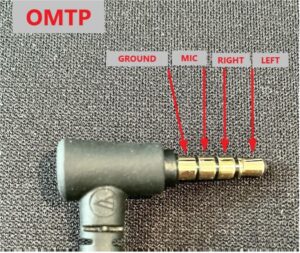Why Audio-Technica headsets won't work correctly with some older devices
Headsets that utilise a microphone or other control features generally use a TRRS plug. TRRS stands for the connections on the plug itself, which are the tip, ring, ring, and sleeve. These plugs are the same size as your standard 3.5 mm TRS headphone plug, but the extra connection allows for an additional feature. You might find yourself in a situation where your headset doesn't perform as expected or not as optimally when plugged into an older device. A possible reason for this could be an incompatibility between the jack on the device and the plug on the headset. The incompatibility can cause certain features of the headset to not work and/or low or inaudible audio from either the microphone or headphones.
The two main headset wiring standards are CTIA and OMTP. CTIA wiring has become more common in newer devices, such as Apple (although they use a nonstandard CTIA, which will be discussed later), Samsung, Android, and Sony, just to name a few. OMTP wiring was more common in early smartphones and computers from manufacturers like Nokia, Samsung, and Sony. However recently, many of these companies have switched over to the CTIA standard. Due to this shift, all of Audio-Technica’s current headphone models that have TRRS connections are wired as CTIA.
The diagrams below illustrate how the CTIA and OMTP wiring differs when it comes to their corresponding connections. As shown, there are some consistencies between the two, as well as some variance.

The CTIA standard TRRS wiring corresponds with the following: the tip is the left channel audio, the first ring is the right channel audio, the second ring is the ground, and the sleeve is the microphone/control.

The OMTP standard TRRS wiring varies from CTIA with the microphone and ground connections being flipped around. However, the left and the right channels line up with the CTIA connections. This means that the microphone on the headset may not work, but audio still comes out of both channels.
Now the differences between CTIA and OMTP have been identified, let’s take a look at Apple’s nonstandard version of CTIA. On the surface, Apple’s CTIA wiring looks similar to the CTIA standard, however, Apple has a nonstandard control-signaling method. This helps Apple maintain more exclusivity for their products, and limits third-party products. So what happens if you use a CTIA standard plug in an Apple nonstandard jack, or vice versa? Well, you could find that some controls on the headset may work fine while others do not work at all. Fortunately, Audio-Technica’s headsets have been designed with this in mind, and are compatible with both standard CTIA wiring and Apple’s nonstandard CTIA.
If you find yourself in a situation where your device's socket is a 3.5mm jack wired as OMTP, while your headset is wired as CTIA, then you could use our ATR2x-USB 3.5 mm to USB Digital Audio Adapter to bypass the jack and use the USB port as the input. The ATR2x-USB has both dedicated headphone and microphone inputs, and can be used with many TRRS breakout cables. The ATR2x-USB is compatible with USB A and USB C inputs, which allows it to be used with many devices on the market.
If you have further questions regarding headset wiring standards, please contact us.